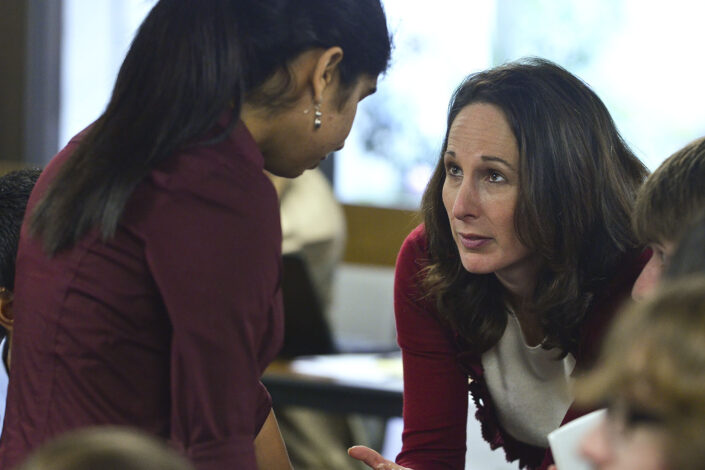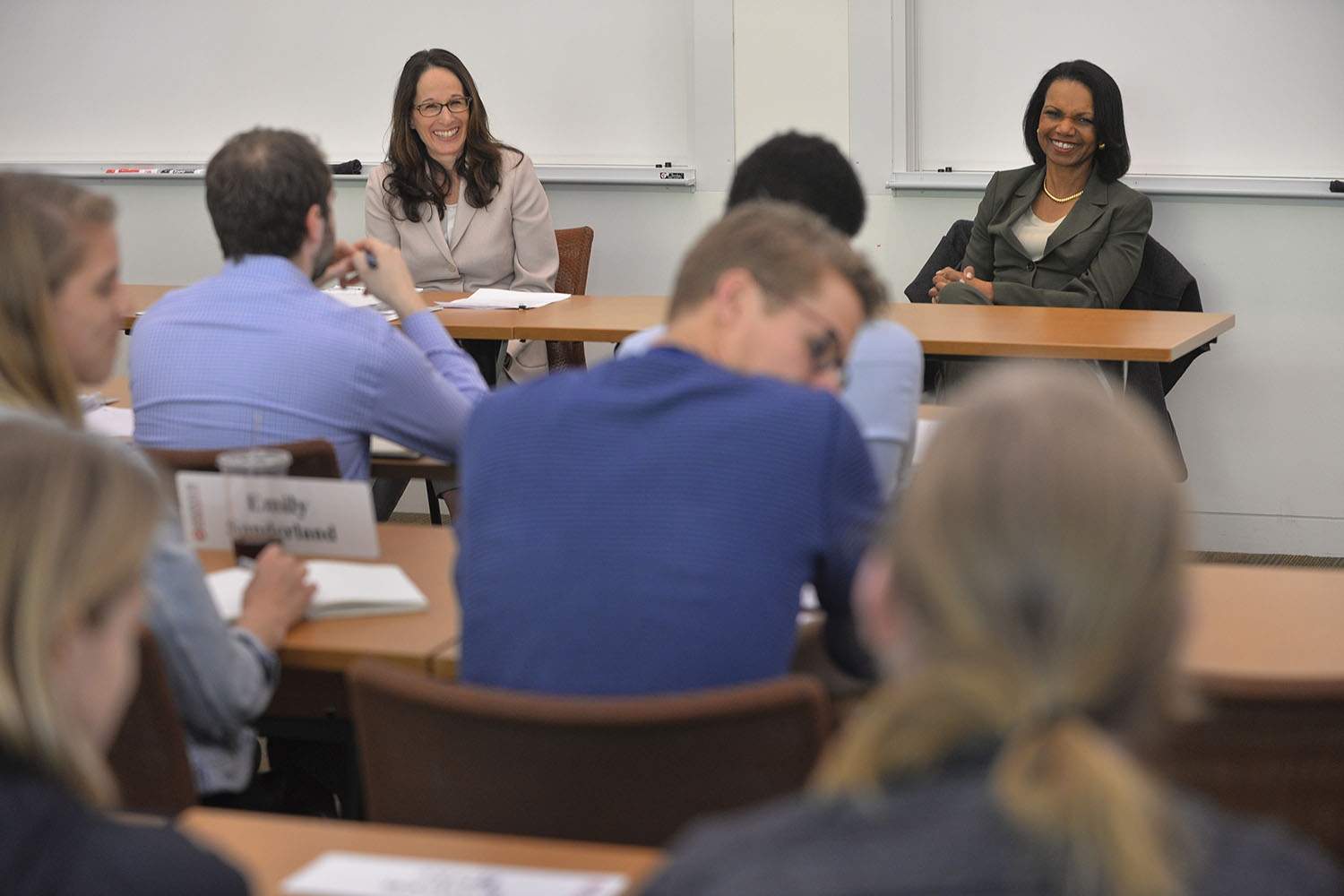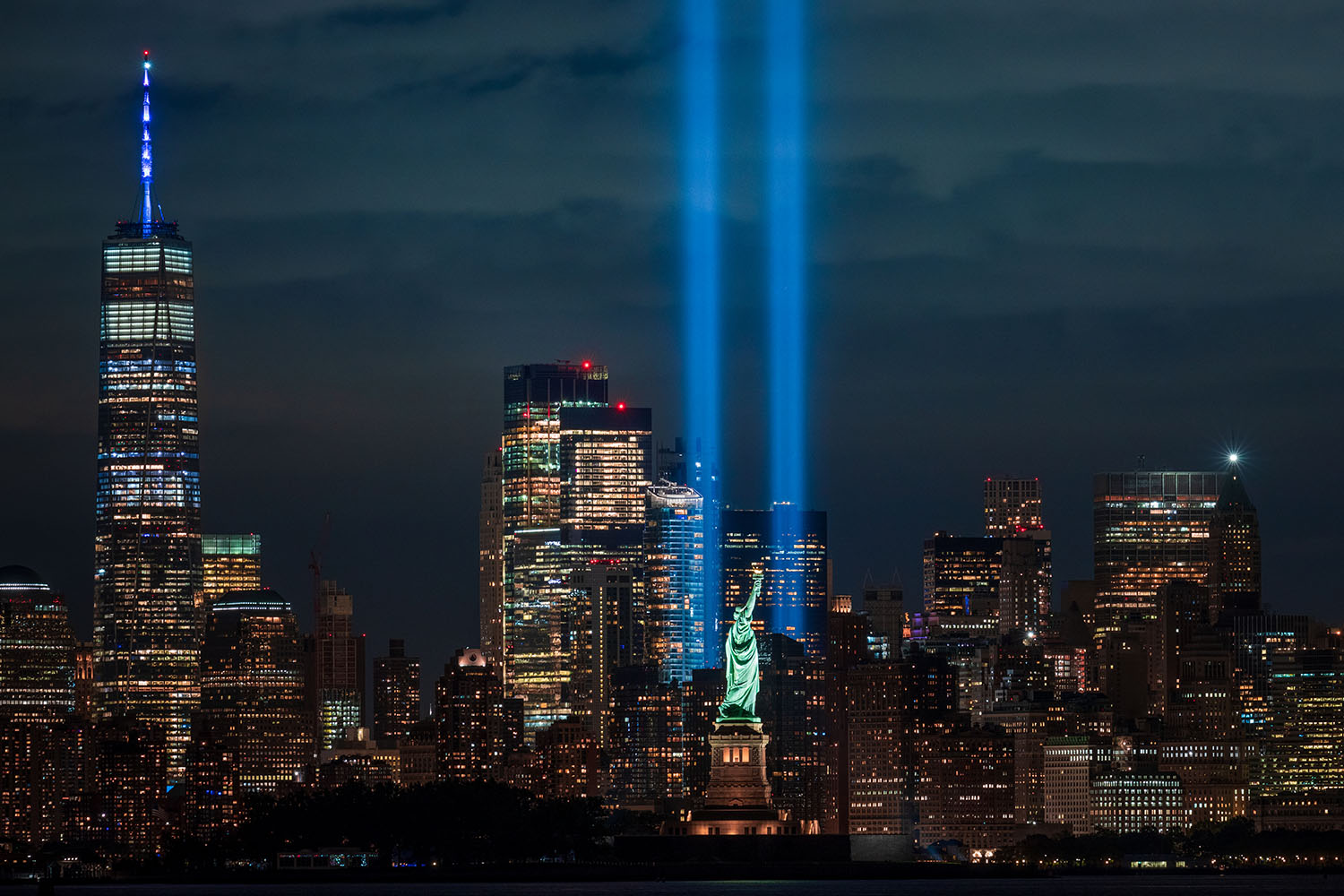How Stanford scholars are teaching the next generation about 9/11
On the 20th anniversary of 9/11, four Stanford scholars and leading experts in national security, terrorism and contemporary conflict – Condoleezza Rice, Amy Zegart, Martha Crenshaw and Lisa Blaydes – reflect on how their teaching of the terrorist attacks has evolved.
For those who remember Sept. 11, 2001, details of the day – the confusion, chaos and collective grief – are as clear now as they were 20 years ago when the deadliest terrorist attack in U.S. history occurred.
But many college students today have no memories of 19 al-Qaida operatives hijacking four commercial airplanes and killing nearly 3,000 people in a terrorist attack on the twin towers of the World Trade Center in New York City, the Pentagon outside Washington, D.C, and a field in Shanksville, Pennsylvania.
Teaching this next generation about the passion and the intensity that defined that pivotal moment is difficult, says Condoleezza Rice, who was the U.S. National Security Advisor at the time of the attacks.
For the new generation of students, 9/11 is now a part of history. “It would be like people trying to convey the intensity of World War II to me,” said Rice, who went on to serve as the 66th secretary of state of the United States under President George W. Bush before returning to her professorship at Stanford in 2009.
Rice, now the Tad and Dianne Taube Director of the Hoover Institution, was in the White House on that Tuesday morning of Sept 11. When she discusses the attacks with her students, her experiences on that day inevitably come up.
She is candid in her recounting. “That helps to vivify it because it’s a personal story,” Rice said.

When President George W. Bush returned to Washington, D.C., on Sept. 11, 2001, he met with Condoleezza Rice, who was then U.S. National Security Advisor, as well as from left: Vice President Dick Cheney, Chief of Staff Andy Card and Special Agent Carl Truscott of the U.S. Secret Service in the Presidential Emergency Operations Center of the White House. (Image credit: Eric Draper, Courtesy George W. Bush Presidential Library / Getty Images)

Condoleezza Rice, who served as President George W. Bush’s national security advisor before becoming the 66th Secretary of State of the United States, is pictured here taking notes from a phone call through a window in the Outer Oval Office on September 18, 2001. (Image credit: Smith Collection / Gado / Getty Images)
Rice shares how, when the first plane hit the North Tower at the World Trade Center at 8:46 a.m., she and others were uncertain about the cause of the crash. She remembers wondering whether it could have been an accident. But when the second hijacked plane hit the remaining South Tower 17 minutes later, Rice knew it had to be a terrorist attack on the United States.
Then there was the short period when Defense Secretary Donald Rumsfeld could not be reached because the Pentagon was also hit that morning, Rice said. She, along with other senior government leaders, were ushered into the White House bunker. She tells students that around noon that day, oxygen levels started to drop because too many people were crammed into the fortified space. “So the Secret Service was going around saying, ‘You have to leave, you are not essential; you have to leave, you are not essential.’ You would never plan for such a thing as that,” she said.
Inevitably, a student will ask her if she was afraid. Rice was so taken aback the first time she faced that question that she actually paused to think about it – and then concluded that she wasn’t. “I didn’t have time to be scared,” Rice recalled. “You can fear for your loved ones, but you are not allowed to feel personal fear. You don’t think about that in the moment.”
“I try to help [students] understand how we are still living the effects of 9/11.”
—Condoleezza Rice
Director, Hoover Institution; Former U.S. National Security Advisor and 66th Secretary of State
Rice also emphasized the importance of talking to students about how 9/11 transformed the world and that what seems routine today – such as additional airport screenings and the formation of new government institutions – didn’t even exist before the attacks.
“I try to help them understand how we are still living the effects of 9/11,” said Rice. “It isn’t an event that happened one day and then was over, but everything from the way that you go through an airport to something called ‘homeland security,’ which you didn’t have before 9/11.”
Teaching 9/11 since 9/11
The attacks also introduced into the wider vernacular new places – like Afghanistan – and people – like Osama bin Laden – that students 20 years ago knew very little or nothing about.
Stanford scholars Amy Zegart and Martha Crenshaw experienced this firsthand on the day of the attacks when they found themselves in the surreal situation of teaching about 9/11 on 9/11. Both were so shocked by the unfolding events that they were unable to do anything except the one thing they were supposed to do that day, which was teach.

Martha Crenshaw, a senior fellow at the Freeman Spogli Institute for International Studies, has written extensively on the issue of political terrorism; her first article, "The Concept of Revolutionary Terrorism," was published in the Journal of Conflict Resolution in 1972. (Image credit: L.A. Cicero)

Zegart led a crisis simulation for POLI SCI 114S: International Security in a Changing World. (Image credit: Rod Searcey)
When they showed up to their respective classrooms – at the time, Crenshaw was at Wesleyan University teaching a course on decision making and foreign policy; Zegart at UCLA – they found them packed. There were more students in the lecture hall for Crenshaw’s course than were enrolled.
Students – horrified and trying to make sense of what was happening – sought clarity and comfort from their teachers, who just happened to be experts on the issues that would come to define the next two decades of U.S. domestic and foreign policy.
“A key part of understanding history is empathy, and thinking about what it was like to live through something rather than only looking at an event through the distance of time. 9/11 looks inevitable in hindsight, but it was unimaginable on September 10.”
—Amy Zegart
Senior Fellow, Freeman Spogli Institute and Hoover Institution
“When something that shocking happens, our natural inclination is to make sense of what’s going on together, right now,” said Zegart, who is a leading scholar on national security and the Central Intelligence Agency and is now a senior scholar at the Freeman Spogli Institute for International Studies (FSI) and the Morris Arnold and Nona Jean Cox Senior Fellow at the Hoover Institution.
Students wanted to know more about the terms and names they were hearing for the first time that day, like jihadism and the Taliban. Over the months that followed came more complex challenges to explain: the global war on terror, torture, rendition, Guantanamo Bay, the wars in Afghanistan and Iraq.
This is the world that today’s students have inherited. Even the current generation’s media, as Zegart’s research has shown, has become increasingly saturated with a proliferation of “spytainment”: movies and TV shows depicting, often inaccurately, the clandestine world of intelligence and counterterrorism operations.
Like Rice, Crenshaw has also found herself having to explain that none of this was normal before 9/11.
“I have to go back and say, ‘All this wasn’t always here before 9/11.’ I have to trace the trajectory of policy changes,” said Crenshaw, a senior fellow at FSI and the Center for International Security and Cooperation.
Shifts in emotion
In the first decade after the attacks, Zegart said her students were incredibly emotional about 9/11 and its aftermath, including the expansion of U.S. conflict abroad. A few years after the wars in Afghanistan and Iraq broke out, Zegart remembers one of her students, a recently returned veteran, telling her that he was taking her intelligence class because he wanted to learn more about why he had gone to Iraq, and what his friend who had deployed with him had died fighting for.

In 2018, Stanford scholars Amy Zegart and Condoleezza Rice co-taught the course POLECON 584: Managing Global Political Risk. (Image credit: Rod Searcey)
“It was a really raw, personal experience for students studying foreign policy in the first decade after 9/11 because they were living with war and uncertainty,” said Zegart. She had to push them be more analytical and objective in their class discussions of what a post 9/11 world entailed.
As the years progressed, though, 9/11 increasingly became less personal for the next generation of students. Perceptions began to shift. So much so that Zegart now finds herself in the opposite predicament: How to insert those feelings back in.
“Because they didn’t live through it, they look at it distantly and dispassionately,” Zegart said. “The challenge is, how do you help students better understand the context in which decisions were made and the raw emotion that unavoidably affects how we perceive threats and how we deal with policy responses.”
Teaching the emotions of the day
To evoke a visceral response to 9/11, Zegart shows a 4-minute montage of news clips. Students get a sense of how the day unfolded, from the breaking reports of the first tower being struck to a reporter’s on-air reaction as the second plane crashes live into the remaining tower. There are also scenes of people fleeing lower Manhattan amid dust, smoke and debris.
“You just cannot convey that day in a normal lecture or a book,” Zegart said. The video is effective; her students are often left with a sense of the sadness, horror and anguish that defined 9/11.
Zegart then asks her students to imagine they are policymakers at the White House and have to decide what to do next. “We often teach U.S. foreign policymaking as a sterile, Spock-like process where people weigh the pros and cons of options and make dispassionate decisions,” Zegart said. “But human emotion and searing national experiences are important and hard to convey. A key part of understanding history is empathy, and thinking about what it was like to live through something rather than only looking at an event through the distance of time. 9/11 looks inevitable in hindsight, but it was unimaginable on September 10.”
Through the exercise, students get a sense of the urgency that policymakers, like Rice, have to grapple with while making decisions amid a national emergency.
“In retrospect, everything looks quite orderly,” said Rice, who co-taught a class on global risk with Zegart at the Graduate School Business. “It looks like ‘of course that decision led to that decision.’ Political scientists are always talking about the options that were put before the president. That’s not how crisis decision making unfolds. You are dealing with really incomplete information, you are dealing with the need to act now, and you are often reacting from instinct because you don’t have time to think through things.”
Viewing the attacks from all sides
When political scientist Lisa Blaydes teaches 9/11 to her students, she tries to give an international perspective of the issues, particularly on how grievances can arise – both legitimately or falsely constructed – in countries abroad and how that can lead to extremism and political violence. For example, in her course Political Science 149: Middle Eastern Politics, several classes are dedicated to examining anti-American attitudes in the Islamic world and the conditions under which individuals become radicalized.
“I try to make sure that students understand both the individual motivations associated with the radicalization of political thought as well as the global context that empowers radicalized individuals to undertake violent action,” said Blaydes, a professor of political science in the School of Humanities and Sciences and a senior fellow at FSI. She asks students to read Lawrence Wright’s book The Looming Tower, which picks up on themes Blaydes covers in the course, particularly those dealing with how authoritarian regimes in the Arab world provided a backdrop for the rise of al-Qaida.

Lisa Blaydes, a professor of political science and a senior fellow at the Freeman Spogli Institute for International Studies, focuses on comparative politics and politics of the Middle East. (Image credit: Courtesy Lisa Blaydes)
In recent years, Blaydes has found her students showing an increased interest in learning more about radical groups like ISIS (Islamic State of Iraq and Syria) and how they have terrorized communities across the Middle East. “While Sept. 11 made terrorism a salient threat for Americans living in U.S. cities, both terrorism and state-sponsored violence are unfortunately a trauma shared by people around the world,” she said.
Similarly, Crenshaw said, it is important to explain to students the conditions that lead to such extremist views. But, she added, explaining motives should not be mistaken as justifying them. “We are not trying to excuse it; we are trying to understand why something happened,” she said.
With her students, Crenshaw has also looked at how terrorism has been used across history. In the aftermath of 9/11, terrorism almost exclusively became associated with a particular ideology and religion. But there are other examples throughout history of how it has been used as a form of political violence, she said.
“As an instructor, one of my goals was always to show students that 9/11 was something extraordinary, but there are other instances of terrorism and it can be associated with any ideology,” Crenshaw said.
Given its elasticity, terrorism is a confusing and contentious term with no standard definition, Crenshaw said. Thus, as both the term and the acts associated with terrorism have evolved over the past two decades, so has her teaching of it. “The phenomenon that you are trying to teach is changing over time as well, so it’s really a very dynamic subject requiring constant adjustment to take into account the vast outpouring of writing on terrorism but changing terrorism and counterterrorism as well,” she said.
In addition to situating 9/11 against a global and historical backdrop, teaching the attacks also requires a critical look at the domestic challenges that led up to it, including the shortcomings in U.S. intelligence. Zegart assigns students an article she wrote about the failures within the U.S. intelligence communities to adapt to the threat of terrorism, as well as a critique against her piece. “There’s no one perfect view, and if students can realize that their professor is part of an argument and people can disagree, that’s really important,” she said.
Zegart and Crenshaw have also assigned students the 9/11 Commission Report, the official report of the events that led up to the attacks and detailed account of the circumstances surrounding it.
‘Still hard’
Even though 20 years have passed since 9/11, it does not mean that teaching about the attacks has gotten easier.
“I still have a hard time,” Zegart said. “For years, my screensaver was a picture of the first plane hitting the World Trade Center. It was important to me not to forget. I’ve spent my career researching why our intelligence agencies failed to stop 9/11 and how they can better meet threats in the future. I think about that day every day.”

